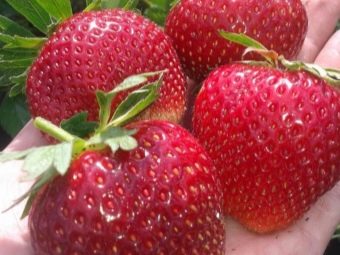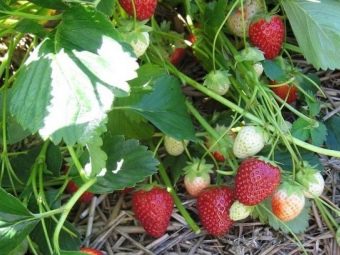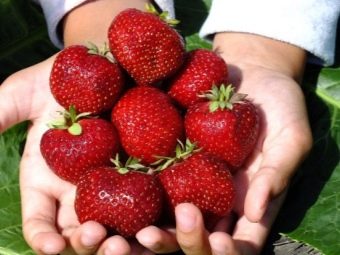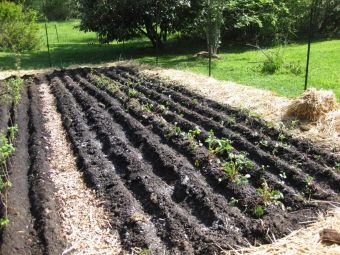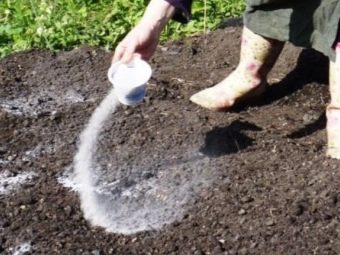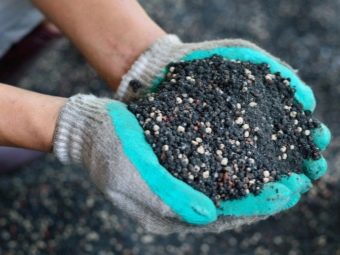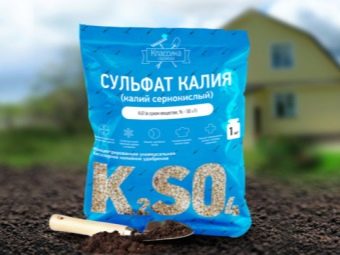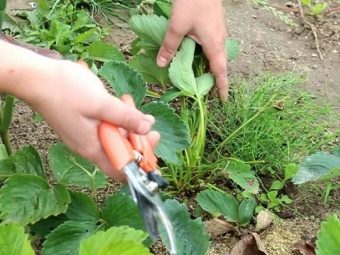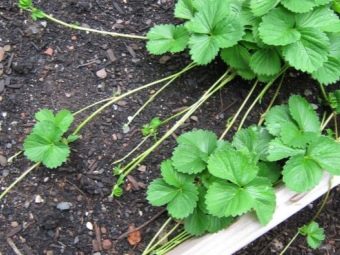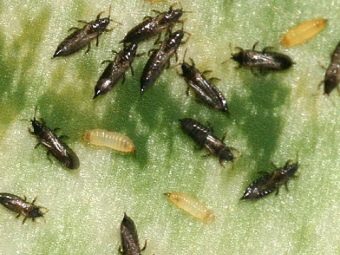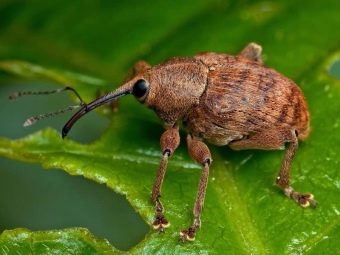Strawberry "Malvina": description and rules of cultivation
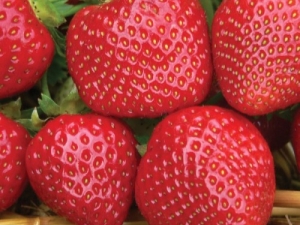
Strawberry is this berry, the appearance of which is eagerly awaited every summer.Therefore, it is important that the proper grade was initially chosen - the one that will please with large sweet fruits in sufficient quantity. Variety "Malvina" just satisfies the specified wishes.
Characteristic variety
Strawberry "Malvina" was bred in 2010 in Germany. The berries ripen quite late - the beginning of the harvest begins approximately from the last days of June to mid-July and lasts from two to three weeks. In principle, the beginning of fruiting, and its duration depends on weather conditions - the warmer and sunnier, the faster the strawberries will ripen. The shape of the berries is very neat and attractive, reminiscent of a flat heart. The color of ripe strawberries is bright, almost cherry. Taste characteristics are also at the level: “Malvina” can be enjoyed with pleasure even at the stage of technical ripeness, but when it finally ripens, it will become even more appetizing. Strawberry smells about the same as garden strawberries.
The Malvina berry is not only beautiful, but also heavy - at the very beginning of the harvesting process, its weight is 35 grams. One bush gives the gardener approximately 800 grams of fruit, but under favorable climatic conditions and proper care, you can increase the number to a kilogram, or even one and a half. The berry is dense, juicy and very persistent - it will not deteriorate during transfer and will not foul. The bediness of the Malvina is very good but requires collection at the stage of technical ripeness. Some berries can also produce small leaves. The surface of one fruit is smooth and shiny. The skin is rather dark, but the pulp is bright crimson, juicy and elastic.
The bush itself grows quite powerful, with strong leaves and abundant horns. Its height reaches 50 centimeters, and the diameter of the bush is 60 centimeters. Flowers appear quite large, besides both sexes, which suggests that the variety does not need additional pollinator. Of course, this is a huge advantage. In addition, the leaves are higher than flower stalks, so the berries do not suffer from heavy sunshine and survive even in the hottest weather. The ability to tolerate low temperatures in the culture is average, so the beds are wrapped with straw or similar material for the winter.
Variety refers to the multi-track, which means the appearance of from 5 to 8 pedicels on each bush. One pedicle, in turn, ensures the appearance of a maximum of six flowers of both sexes. The leaves of “Malvina” are large and shiny, have a rich green tint. They are located parallel to the surface of the earth, which prevents the desiccation of the soil in the hot months.
Malvina has an alluring smell and high sugar content, therefore it is widely used fresh as well: for salads, desserts, casseroles, and for various preparations, for example, jams or compotes. It should be noted that freezing does not spoil the condition of the berries - they remain as tasty and tidy.
Landing
The place for the beds should be well lit and have a flat surface. Another important factor is proper wind protection. Usually beds are located in the direction from north to south or south-west. The soil should be loose and completely cleaned of weeds, residues of roots and other debris. Black earth and loam are considered ideal.
In no case should Malvina be planted in the shadow of tall trees, in lowlands, on too steep slopes or sandy soils. It is also worth being careful with areas where groundwater is too close to the surface (above 70 centimeters) - when the snow starts to melt, the root system will be flooded, and as a result, strawberries will die. According to the rules of crop rotation, it is necessary to plant this crop after root crops, cabbage, greens and legumes. At one place this variety is allowed to grow up to five years.
Strawberry bushes are planted so that between them there is a gap of 60 centimeters. In addition, one row from the other will be separated by 70 centimeters, which ultimately forms a rather atypical scheme for this culture. It is important to mention that the chess order is most often used, as the bushes are quite powerful and take up a lot of space.
Planted "Malvina" usually in the spring. In the first year there should not be a lot of strawberries, but in the second a large number of delicious berries are expected. Autumn planting for this variety changes to August, which is carried out in the last week of summer. This transfer is explained by the fact that early frosts can harm the immature root system.
Preparing the soil for strawberries, it is necessary to make enough organic fertilizers, as the culture actively absorbs nitrogen from the earth. The beds are usually prepared in advance so that the ground has time to settle. The digging is carried out at a depth of 20 to 30 centimeters. If planting will be carried out on clay soils, up to three to four kilograms of river sand and a couple of buckets of organic fertilizers should be added to each square meter of land. The acidity of the soil must be either neutral or weak. If necessary, processing of dolomite flour is carried out - four kilograms are applied to one square meter of bed.
In warm regions, the berries are planted in the middle of spring, and in cooler regions - in the first weeks of May. Before the procedure, too large roots are shortened so that their length ranges from 5 to 7 centimeters. Then they are dipped into a solution of clay, water and cow dung. The holes are dug up almost square, their side should reach 25 centimeters. Water is poured inside, and then seedlings fall vertically. It is important to ensure that nothing happens to the roots, for example, they are not twisted. It is also important to adjust the height - if you plant the Malvina too deep, it will rot, and too high it will quickly dry. The so-called "heart" should be on the line of the soil. The land swathes around and everything is irrigated. The final step should be the mulching of the surface.
Care
Malvine needs a sufficient amount of nitrogen, which it actively absorbs from the soil. Therefore, this substance must be made independently. Twice a season it is recommended to feed strawberries with ammonium nitrate solution. This treatment is foliar, and the concentration of fertilizer should be two times less than at root.
Fertilization is usually carried out when the culture is actively increasing the green mass. It is important that the weather is overcast, and it is better to do this in the evening. It is also not recommended to feed the bushes just before the rain. Otherwise, the sheets will either be burned or the fertilizer will be washed away with water. Organic fertilizers containing superphosphate or supplemented with ashes are optimal.
In addition, “Malvina” will be delighted with potash fertilizer without chlorine, for example, potassium sulfate. It is made when the growing season starts. It is also permitted to simply confine with ashes: both as a powder and as a solution. It should be mentioned that dry dressing is completed by loosening and watering.
Of course, it is important to ensure the culture of high-quality watering, otherwise the berries will acquire a bitter taste. In addition, when drought decreases the weight of the fruit, which means that the yield is also changing for the worse. Therefore, watering should be regular, especially during the dry months. Experts also recommend making it drip.
Important is the procedure such as cutting sheets. Its implementation will allow the light to go where previously there was no access, thereby accelerating the development of the fruit. During harvest, the effect will also be noticeable.
When the strawberries are planted in the spring, in the summer it should be watered almost every day.If in the fall, the watering begins at the end of April, that is, when the growing season starts. Before summer irrigation takes place once a week, and 30 liters of liquid are used per square meter of bed. From the beginning of summer to autumn, the number of irrigations increases twice, but natural irrigation is also taken into account. It is necessary to saturate the culture with moisture when the ovaries are formed, when Malvina actively fructifies and the buds of the flowers are formed.
Since Malvina produces enough whiskers, there are no problems with reproduction of this variety.
Diseases and pests
Generally, Malvina is not afraid of most diseases, and insects rarely attack it. But culture often becomes a target for thrips and weevils, cabbages and slugs. To prevent the attack of weevils, beds before planting, after picking berries and during flowering are treated with a special tool called "Aktara". It also helps from thrips. In addition, you can use "Aktophyt" and other solutions. In addition, between rows it is advised to plant crops that can scare off pests by smell. If the culture is still attacked by insects, then all damaged parts must be removed.
Of the diseases, the most likely are those caused by fungal microorganisms. Often, "Malvina" develops brown spot and gray rot. Problems are signaled by symptoms such as softening of the berries and a change in their color to an unpleasant gray. Since gray rot often occurs due to excessive moisture, it is recommended to scatter sawdust between the rows of strawberries as a preventive measure. In addition, even before flowering, strawberries are treated with copper oxychloride. Usually one tablespoon is diluted in 10 liters of liquid, and one liter of solution is enough to process one square meter of bed.
When the entire crop is harvested, the plant should be treated with the same substance, but in different proportions. Two tablespoons of copper oxychloride are diluted in a bucket of water with liquid soap or soap shavings.
Gardeners reviews
According to summer residents, the Malvina variety produces berries that have an attractive appearance and amazing taste. In addition, they marked an extended fruiting period, allowing for two weeks more to enjoy the harvest. The variety produces very strong and stable bushes, not afraid of either cold and heavy rainfall, nor heat and drought.
Berry transportation goes without any problems. Although the culture bears fruit rather late, few consider it a minus, because one sort of strawberry is conveniently replaced by another. Berries are actively consumed fresh, as well as processed into salads and smoothies, yoghurts and cocktails.
In the next video you will find a lot of useful information about the Malvina strawberry variety.

